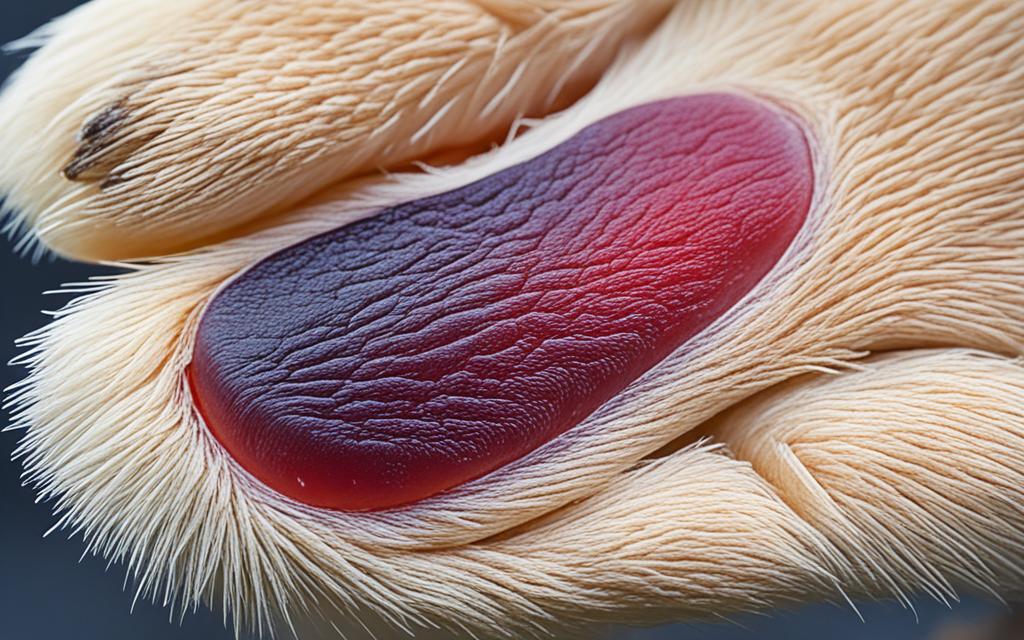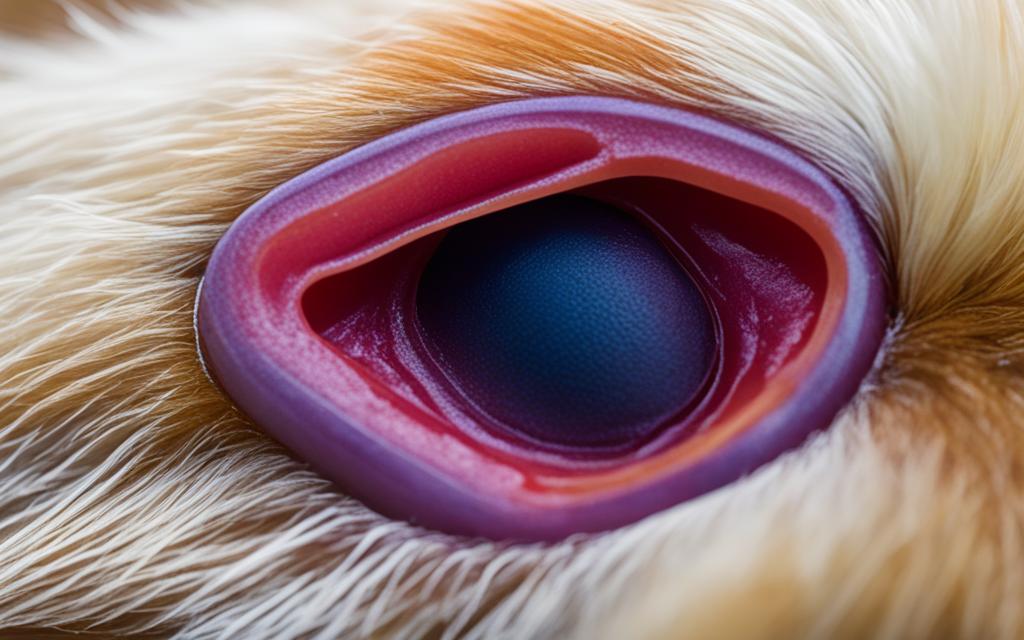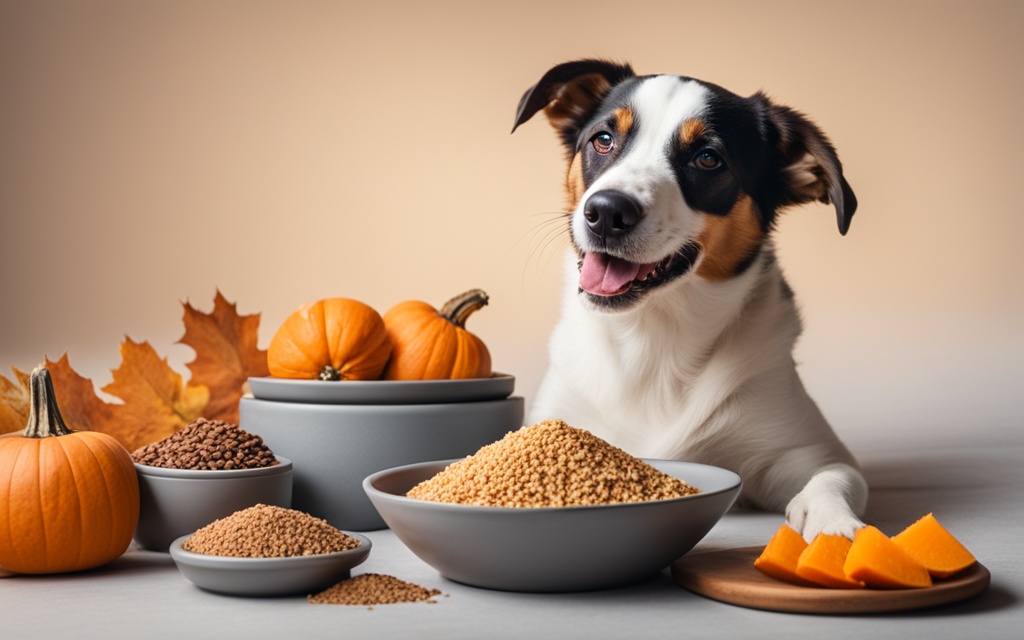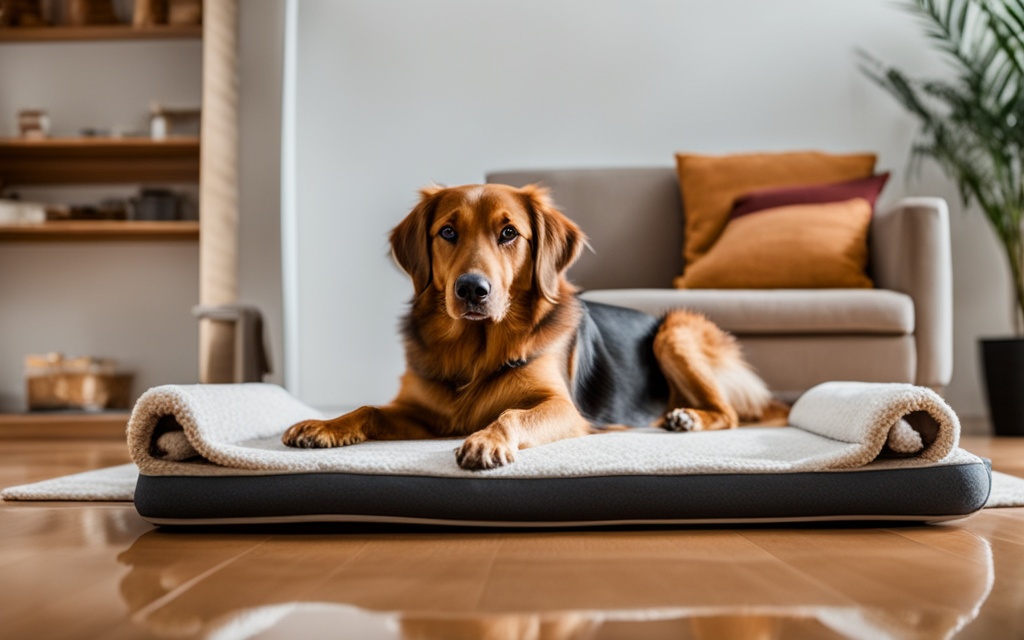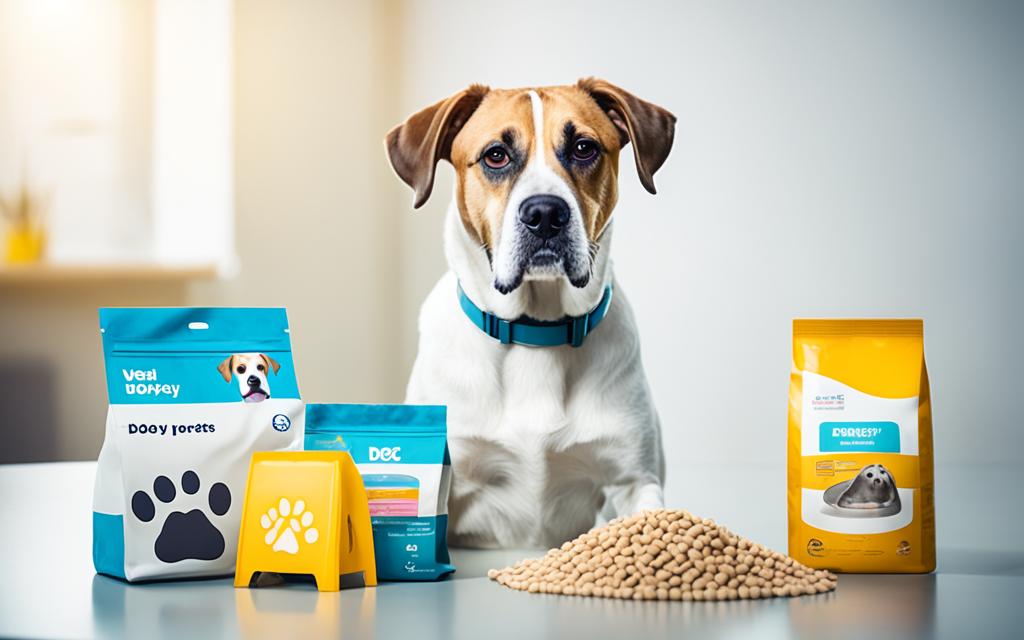About 20% of adult dogs suffer from joint problems. Issues like arthritis, hip dysplasia, and patellar luxation cause pain and make moving hard. It’s important to spot joint pain early in your dog. Doing so can make a big difference in their life. This guide will show you how to help your dog stay active and happy.
Understanding Joint Problems in Dogs
Joint problems can really change a dog’s life. Knowing about the different types and causes helps owners act early. Many dogs get arthritis because they’re older or live certain ways.
Common Types of Joint Issues
There are many joint problems dogs can face. Here are some main ones:
- Osteoarthritis: This is a degenerative joint disease that older dogs often get. It happens when the cartilage wears out.
- Hip Dysplasia: This is a genetic issue that makes the hip joint form wrong. It causes pain and makes moving hard.
- Ligament Injuries: Injuries to ligaments, like the cranial cruciate ligament, can make joints unstable and hurt a lot.
Causes of Joint Pain in Dogs
Knowing why dogs get joint pain helps in preventing and treating it. Some main reasons are:
- Genetic Factors: Some breeds are more likely to have joint problems. Knowing about breed traits is key.
- Age: Older dogs’ joints naturally wear down, leading to arthritis.
- Obesity: Being overweight puts more stress on joints, making them more prone to injury and pain.
- Previous Injuries: Past injuries can cause ongoing joint problems. It’s important to know a dog’s health history.
Recognizing the Signs of Joint Problems
It’s important to know the signs of joint problems in dogs. Owners should watch for changes in behavior and physical signs of pain. Spotting these early can lead to better treatment and a happier life for your dog.
Behavioral Changes
Behavior changes often mean a dog has joint issues. Watch for these signs:
- Decreased activity levels, such as reduced playtime or longer sleep periods.
- Reluctance to jump or climb stairs.
- Changes in mood, exhibiting signs of irritability or withdrawal.
- Difficulty in getting up after resting or lying down for extended periods.
Physical Symptoms to Watch For
Physical signs are also key to spotting joint problems. Look out for these symptoms:
- Limping or favoring one leg while walking.
- Stiffness, particularly noticeable after long periods of rest.
- Swelling around affected joints.
- Difficulty in standing up or lying down comfortably.
The Importance of Early Detection
Spotting joint problems early can greatly improve a dog’s health. Catching joint issues early means you can take steps to help them. This leads to a better outcome for your pet’s health.
Benefits of Timely Intervention
Acting fast when you see joint signs is key. Here are the main benefits of treating problems early:
- Reduced pain levels: Early treatment often makes dogs feel better, improving their health and happiness.
- Slower disease progression: Quick action can slow down joint problems, keeping your dog moving and healthy longer.
- Improved mobility: Dogs that get early care usually keep their joints flexible and agile, making everyday tasks easier.
- Enhanced quality of life: Research shows that dogs getting quick care often live a happier life as they get older.
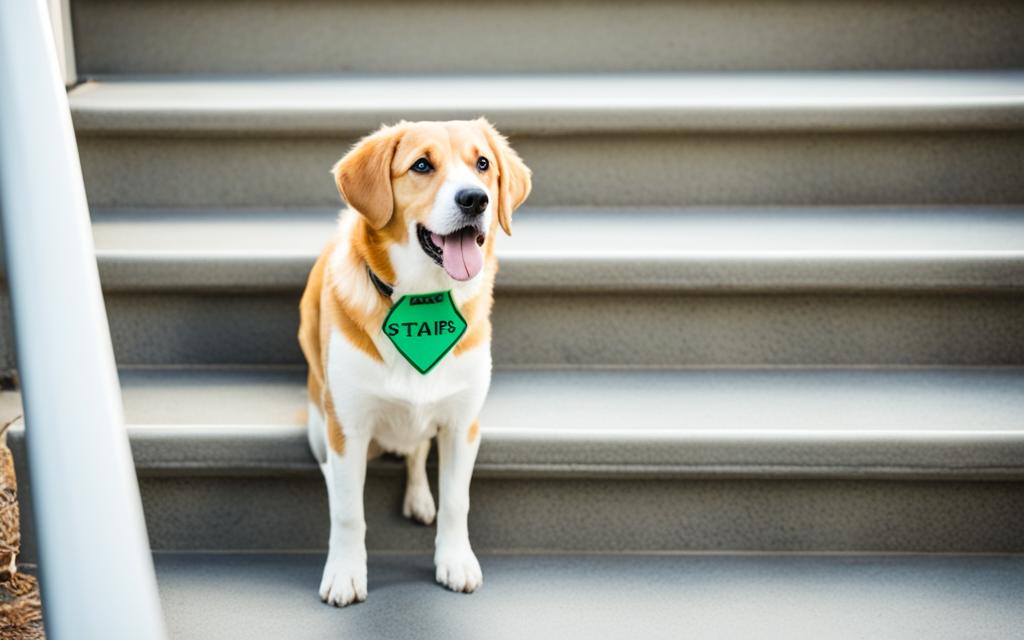
Identifying and Treating Dog Joint Problems
It’s vital to seek professional help for your dog’s joint issues. A vet is key in giving the right diagnosis and treatment. They use their knowledge to check symptoms, run tests, and create a treatment plan.
Diagnosis by a Veterinarian
Seeing a vet is crucial if your dog shows joint problems. They will look at your dog’s health history and symptoms. This helps decide if more tests are needed.
They will also check how well your dog moves and how much pain they feel. This is important for a correct diagnosis.
Common Diagnostic Tests
Vets use different tests to figure out what’s wrong with a dog’s joints. These tests include:
| Diagnostic Test | Purpose |
|---|---|
| X-rays | Reveal bone structure, detect fractures or joint abnormalities. |
| MRI | Offer detailed images of soft tissues, cartilage, and ligaments. |
| Blood Tests | Identify infections, inflammatory markers, or autoimmune disorders. |
| Joint Fluid Analysis | Examine the synovial fluid for signs of infection or inflammation. |
These tests help understand what joint issues your dog has. By doing these tests, you can make sure your dog gets the right care for their needs.
Non-Surgical Treatment Options
Non-surgical treatments are great for dogs with joint problems. They offer many ways to help manage pain. These include medications, supplements, and physical therapy that can make dogs feel better and help them recover.
Medications for Pain Management
There are many medications that can help dogs with joint pain. Non-steroidal anti-inflammatory drugs (NSAIDs) are often used because they reduce inflammation and ease pain. Steroids can also be given to help during bad flare-ups. Always talk to a vet to find the right medicine for your dog.
Supplements that Support Joint Health
Adding joint health supplements can also help dogs with joint issues. Supplements like glucosamine and chondroitin sulfate keep cartilage healthy and can stop it from getting worse. These supplements are key for keeping dogs moving well and supporting their joints over time.
Physical Therapy and Rehabilitation
Physical therapy is a great choice for dogs with joint problems. Hydrotherapy is a type of therapy that uses water to help ease joint stress and strengthen muscles. Working with a professional to create a rehab plan can also help dogs recover and improve how well their joints work. This kind of care is good for joint health and makes dogs feel better overall.
| Treatment Type | Description | Benefits |
|---|---|---|
| NSAIDs | Reduces inflammation and alleviates pain | Fast relief from discomfort |
| Steroids | Provides relief during acute flare-ups | Quick action in severe cases |
| Glucosamine | Supports cartilage health | Aids in joint function and longevity |
| Chondroitin Sulfate | Helps prevent cartilage breakdown | Maintains joint mobility |
| Hydrotherapy | Water-based exercises reduce joint stress | Increases strength and flexibility |
| Therapeutic Exercises | Custom exercises to improve mobility | Builds muscle strength and supports recovery |
What Role Does Diet Play in Joint Health?
A balanced diet is key for your dog’s joint health and overall well-being. Dogs with joint problems can benefit from certain nutrients. These nutrients help reduce inflammation and improve their life quality. It’s important for pet owners to know about these nutrients for their dogs’ joints.
Nutrients Essential for Joint Support
Key nutrients for joint health include:
- Omega-3 fatty acids, known for their anti-inflammatory properties.
- Glucosamine and chondroitin, which are essential for cartilage repair and maintenance.
- Antioxidants, like vitamin E and C, that help combat oxidative stress in the joints.
- Omega-6 fatty acids, which also play a role in reducing inflammation.
Adding these nutrients to your dog’s diet can help ease discomfort and improve mobility. They are key for any joint health plan for dogs.
Best Dog Foods for Joint Health
Choosing the right dog food is crucial for joint health, especially for dogs with arthritis. Here are some top brands that offer great options for joint support:
| Brand | Product | Nutritional Highlights |
|---|---|---|
| Hill’s | Science Diet Joint Health | Includes omega-3 fatty acids and antioxidants. |
| Royal Canin | Joint Care | Rich in glucosamine and chondroitin. |
| Blue Buffalo | Life Protection Formula | Contains omega-3s and life source bits for overall health. |
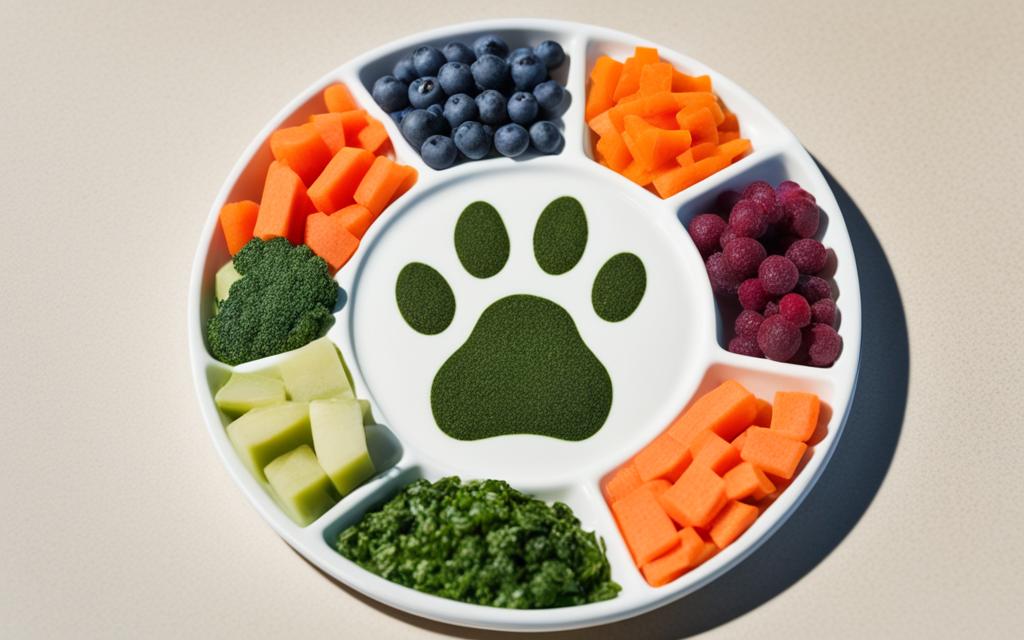
By adding these top dog foods for arthritis to your dog’s diet, you give them the support they need for joint care and a better life.
When Surgery May Be Necessary
Surgery is key for dogs with serious joint problems. Sometimes, other treatments don’t work, and surgery is needed to help dogs move better and feel less pain. It’s important for pet owners to know about the surgery options available.
Common Surgical Procedures for Joint Problems
There are different surgeries for dogs with joint issues. Some common ones are:
- Arthroscopy: A procedure that lets vets check and fix joint problems without a big cut.
- Cruciate Ligament Surgery: This surgery helps dogs with knee injuries to the cruciate ligament.
- Hip Replacement: Needed for dogs with severe hip dysplasia or arthritis.
Post-Surgery Care and Recovery
Recovery after surgery is crucial for a good outcome. Owners should:
- Pain Management: Give the dog the pain medicine the vet says to help with pain.
- Rehabilitation: Use physical therapy to help the dog move better and heal faster.
- Follow-Up Care: Take the dog to regular vet check-ups to see how they’re doing.
Preventing Joint Problems in Dogs
To keep your dog’s joints healthy, focus on keeping them at a good weight and making sure they have fun, safe activities. Regular exercise helps with weight control and makes muscles and joints stronger. It’s important to pick activities that fit your dog’s needs to keep them healthy and avoid injuries.
Regular Exercise and Weight Management
Exercise is key to stopping joint problems in dogs. A good exercise plan keeps your dog at a healthy weight. This is important because being overweight puts too much stress on their joints. You can try different activities like:
- Leashed walks for cardiovascular health
- Swimming for low-impact resistance
- Fetch games to stimulate both mind and body
Choosing the right exercise for your dog’s age and breed helps with weight control and keeps their joints healthy.
Safe Activities for Joint Protection
Picking safe activities for your dog helps protect their joints. Simple steps can make a big difference, such as:
- Warming up with gentle stretches before playtime
- Avoiding hard surfaces during exercise to reduce impact
- Limiting strenuous activities in extreme weather conditions
These tips help your dog stay safe and happy. Always watch how active your dog is to prevent joint problems and keep them healthy for a long time.
Monitoring Your Dog’s Joint Health at Home
It’s important to keep an eye on your dog’s joint health for their overall well-being. Regular checks can spot changes early, which might mean they need more attention. Using a dog joint health checklist can help you notice any signs that worry you quickly.
Daily Observations and Checklists
Watching your dog every day is key to keeping track of their health. Here’s a checklist to help you monitor their joint health:
- Observe your dog’s mobility: Does your dog have trouble getting up or lying down?
- Watch for limping or stiffness during walks and after resting.
- Notice if your dog is less active: Is your dog not wanting to play or do their usual activities?
- Check for swelling or tenderness around joints: Gently feel your dog’s legs and joints for any oddities.
- Keep an eye on your dog’s weight: Too much weight can put more strain on their joints.
When to Consult Your Veterinarian
Don’t wait to act on your dog’s joint health. Call a vet if you see any of these signs:
- Long-lasting limping or trouble moving.
- Pain signs during normal activities or when handling them.
- Changes in behavior like being more irritable or avoiding social contact.
- Visible swelling or heat around joints.
- Sudden weight gain, which could make things worse.
The Psychological Impact of Joint Problems on Dogs
Joint problems in dogs affect more than their physical health. The pain they feel can change their behavior. Owners need to understand these changes to support their dogs.
Understanding Behavioral Changes in Pain
Joint pain can change a dog’s behavior. Look out for signs like:
- Increased irritability or aggression.
- Avoidance of certain activities previously enjoyed.
- Changes in eating or sleeping patterns.
- Increased vocalizations, such as whining or barking.
- Reluctance to engage with owners or other pets.
These changes often come from the pain. It’s important for owners to watch their dogs’ emotional and psychological health.
Supporting Your Dog Through Recovery
To help dogs with joint problems, create a supportive space. Consider these steps:
- Set up a quiet spot for your dog to rest.
- Use positive reinforcement for gentle activity.
- Give them mental stimulation with toys and games.
- Talk to vets about pain management and therapies.
- Keep a routine to offer stability and reassurance.
These steps can help support your dog’s mental health while they heal from joint pain.
| Behavioral Changes | Possible Causes | Recommended Support Strategies |
|---|---|---|
| Increased irritability | Discomfort from pain | Provide a peaceful sanctuary |
| Avoidance of activities | Fear of pain during movement | Encourage gentle play with positive reinforcement |
| Changes in appetite | Stress or pain | Consult a vet for dietary advice |
| Desire for solitude | Increased anxiety | Spend quality time without overstimulation |
Conclusion
Keeping your dog’s joints healthy is key to their happiness and activity. We’ve looked at how to spot joint issues early and the different ways to treat them. From non-surgical methods to surgery, each option helps improve your pet’s life.
It’s important to watch your dog’s joint health closely. Regular vet visits and noticing any changes can help with treatment. The main thing is to care for your pet’s health with good food, exercise, and regular vet check-ups.
Being informed and active helps pet owners support their dogs’ joints and comfort. We hope this summary helps you take the right steps for your dog’s health. This way, your furry friends can stay happy and healthy for a long time.
